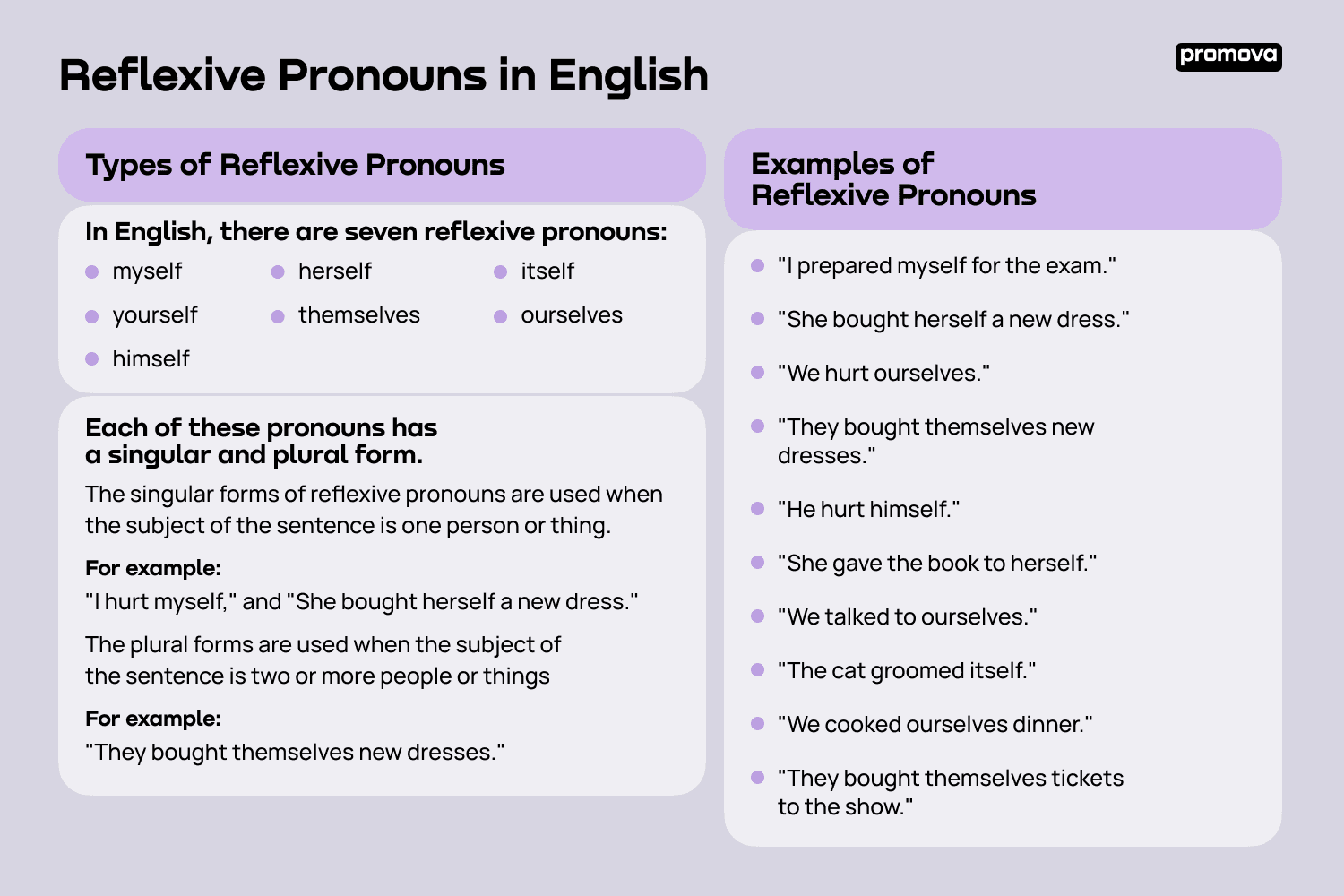Reflexive Pronouns in English
Contents
In this reference, we will get into the details of reflexive pronouns in English. Reflexive pronouns help show that the object of your sentence is the same as its subject. Let's get started!
What are Reflexive Pronouns?
They are pronouns that help refer back to the subject of the sentence or clause. For example, in the sentence "I prepared myself for the exam," the reflexive pronoun "myself" refers back to the subject "I." In English, reflexive pronouns are used to emphasize the subject of the sentence or to refer back to a noun or pronoun in a sentence.
Reflexive pronouns typically end in "-self" or "-selves." They can be used in the subject or object position in a sentence. For example, "I made myself a cup of coffee," and "She bought herself a new dress."
In English, reflexive pronouns are used to emphasize the subject of the sentence or to refer back to a noun or pronoun in a sentence. They are also used help show that the subject of your sentence is performing an action on itself.

Types of Reflexive Pronouns
In English, there are seven reflexive pronouns. These are:
- myself
- yourself
- himself
- herself
- itself
- ourselves
- themselves.
Each of these pronouns has a singular and plural form.
The singular forms of reflexive pronouns are used when the subject of the sentence is one person or thing. For example, "I hurt myself," and "She bought herself a new dress."
The plural forms are used when the subject of the sentence is two or more people or things. For example, "We hurt ourselves," and "They bought themselves new dresses."
7
Functions of Reflexive Pronouns
Reflexive pronouns can serve several different functions in a sentence. They can be used to emphasize the subject of the sentence, to refer back to a pronoun or noun in the sentence, or to indicate that the subject is performing an action on itself.
When reflexive pronouns are used to emphasize the subject of the sentence, they are usually placed at the end of the sentence. For example, "I did it myself." This emphasizes that the subject of the sentence (I) was the one who did the action.
Reflexive pronouns can also be used to refer back to a pronoun or noun in the sentence. For example, "She gave the book to herself." In this sentence, the reflexive pronoun "herself" is used to refer back to the pronoun "she."
Finally, they indicate that the subject of your sentences is performing an action on itself. For example, "He cut himself." In this sentence, the reflexive pronoun "himself" indicates that the subject (he) is performing the action (cutting) on itself.
Reflexive Pronouns in English Grammar
Reflexive pronouns are usually placed at the end of the sentence. For example, "I prepared myself for the exam." In this sentence, the reflexive pronoun "myself" is placed at the end of the sentence to emphasize the subject (I).
Reflexive pronouns can also be used to refer back to a pronoun or noun in the sentence. For example, "She gave the book to herself." In this sentence, the reflexive pronoun "herself" is used to refer back to the pronoun "she."
Examples of Reflexive Pronouns
Here are some examples of reflexive pronouns in sentences:
- "I prepared myself for the exam."
- "She bought herself a new dress."
- "We hurt ourselves."
- "They bought themselves new dresses."
- "He hurt himself."
- "She gave the book to herself."
- "We talked to ourselves."
- "The cat groomed itself."
- "We cooked ourselves dinner."
- "They bought themselves tickets to the show."
Reflexive Pronouns vs Intensive Pronouns
It is important to note that reflexive pronouns are often confused with intensive pronouns. Intensive pronouns are also used to emphasize the subject of the sentence, but they are not used to refer back to a pronoun or noun in the sentence.
For example, "I did it myself" is a sentence with a reflexive pronoun, while "I myself did it" is a sentence with an intensive pronoun. The intensive pronoun in this sentence is emphasizing the subject (I) but it is not referring back to any other noun or pronoun.
Summary
Reflexive pronouns can serve several different functions in a sentence. They can be used to emphasize the subject of the sentence, to refer back to a pronoun or noun in the sentence, or to indicate that the subject is doing something. Hopefully, this reference helped you make sense of reflexive pronouns and improved your ability to use them!
Comments